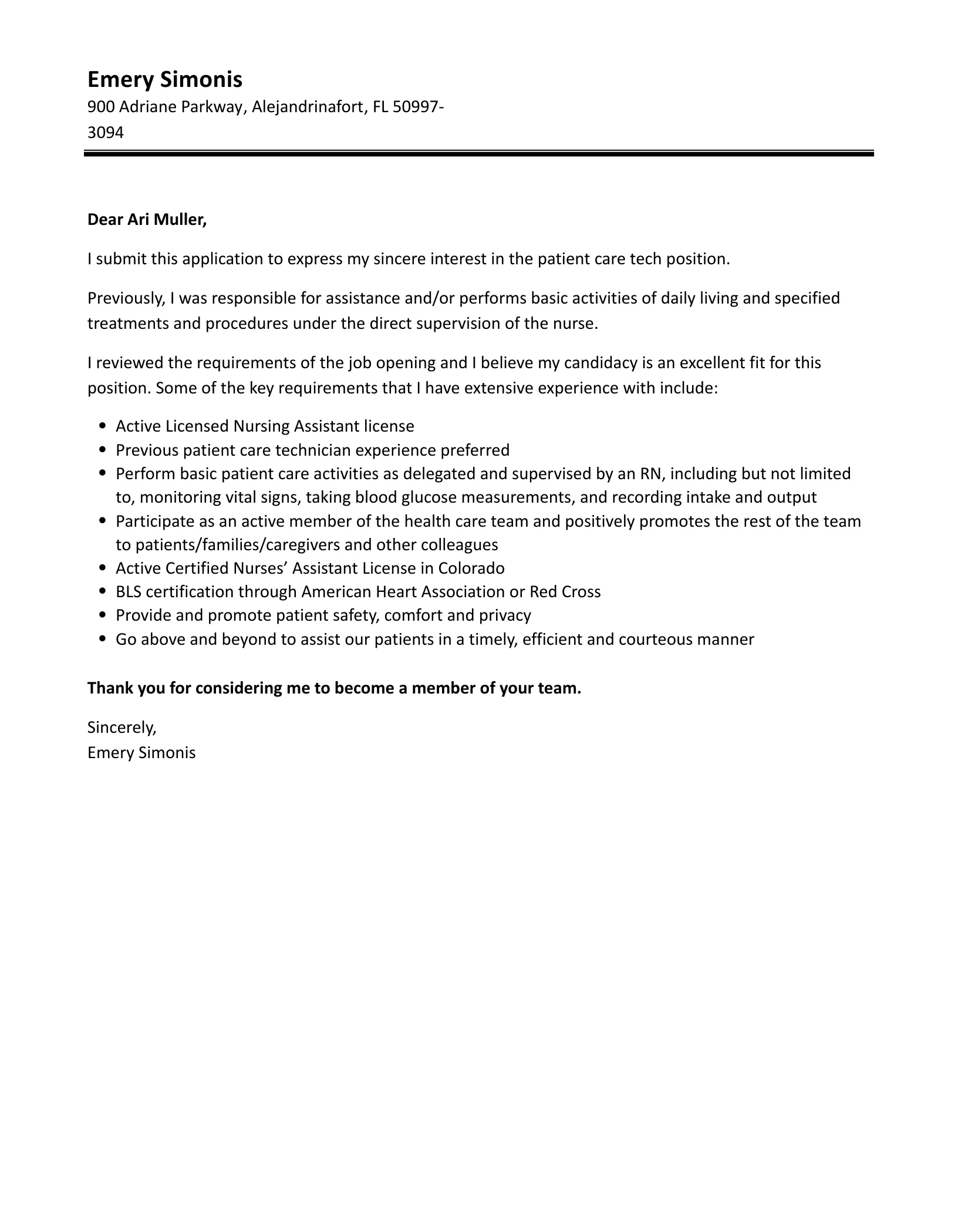Crafting a Patient Care Technician Cover Letter
A compelling Patient Care Technician (PCT) cover letter is your first step toward landing your dream job in the healthcare field. It’s your chance to make a strong first impression, showcase your skills and experience, and demonstrate your enthusiasm for the role. A well-crafted cover letter complements your resume, providing context and personality that a list of qualifications alone cannot convey. This guide will walk you through the essential elements of a cover letter that will help you impress potential employers and increase your chances of getting an interview. By focusing on clear communication, highlighting relevant skills, and tailoring your letter to each specific job application, you can create a cover letter that sets you apart from the competition and opens doors to rewarding opportunities in patient care. Remember that the goal is to demonstrate your understanding of the role and your commitment to providing excellent patient care.
Understanding the Role of a Patient Care Technician
Before you start writing your cover letter, it’s crucial to understand the responsibilities and requirements of a Patient Care Technician. PCTs play a vital role in healthcare, providing essential support to nurses and physicians. Their duties include assisting patients with daily living activities, monitoring vital signs, and ensuring a comfortable and safe environment. Understanding the core duties allows you to tailor your cover letter, emphasizing the skills and experiences most relevant to the position. This might involve highlighting your ability to work well under pressure, your experience with specific medical equipment, or your strong communication skills. Tailoring your cover letter to the specific requirements of the role will make your application more compelling and show the employer that you have a good understanding of the job. This also shows your genuine interest and enthusiasm for the opportunity. Reflecting your ability to handle diverse tasks and demonstrate a commitment to patient well-being ensures your cover letter resonates with hiring managers and highlights your capabilities in the context of the PCT role.
Highlighting Your Skills in Your Cover Letter
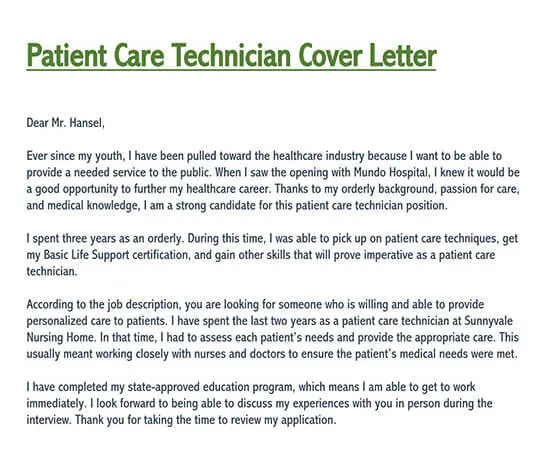
A successful PCT cover letter must effectively highlight your relevant skills. This section is where you convince the hiring manager that you possess the abilities necessary to excel in the role. It’s not enough to just list your skills; you need to demonstrate how you’ve applied these skills in previous roles or experiences. Be specific and provide examples. For instance, instead of saying you have good communication skills, describe a situation where you successfully communicated with a difficult patient or explained a medical procedure clearly. When writing your cover letter, consider the skills that are most important for a PCT, such as communication, empathy, and technical abilities. By highlighting these skills and backing them up with concrete examples, you create a compelling narrative that showcases your capabilities and makes you a strong candidate for the position.
Communication Skills
Effective communication is critical for a PCT. Highlight your ability to clearly communicate with patients, their families, and healthcare professionals. Give examples of how you’ve handled difficult conversations, explained complex medical information, or provided emotional support. Demonstrate your active listening skills and ability to adapt your communication style to meet the needs of different individuals. Show your ability to maintain patient confidentiality and adhere to healthcare regulations. Show how you’ve worked with diverse patient populations, including individuals from different age groups, cultural backgrounds, and health conditions. Showcasing the ability to communicate effectively is a cornerstone of a successful PCT, and it ensures that your application stands out.
Empathy and Compassion
Empathy and compassion are essential qualities for PCTs. Your cover letter should convey your ability to connect with patients on an emotional level and demonstrate a genuine concern for their well-being. Share experiences where you provided comfort and support to patients, addressed their concerns, or advocated for their needs. When highlighting compassion, focus on the positive impact your actions had on patient care and patient outcomes. By demonstrating genuine care and understanding, you show that you’re not just qualified for the role but are also dedicated to providing the best possible care. Sharing specific instances of how you’ve gone above and beyond to support patients can create a strong impression.
Technical Skills
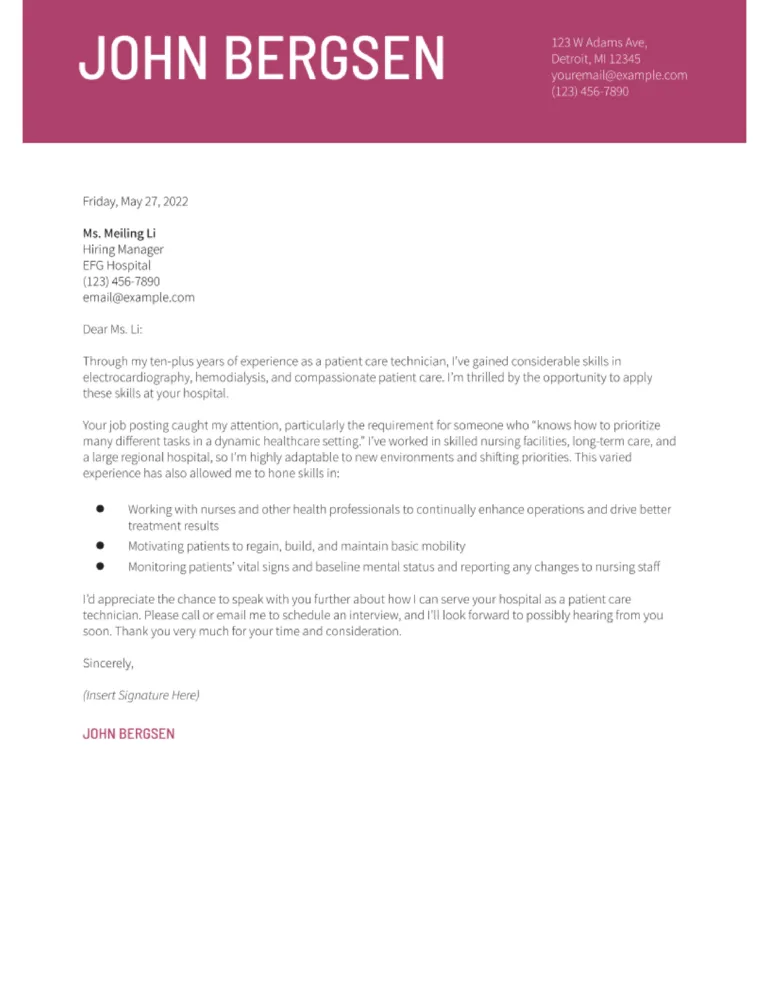
Detail your technical skills, such as taking vital signs, assisting with mobility, and using medical equipment. If you have experience with specific equipment or procedures, be sure to include those. Mention any certifications or training relevant to the PCT role. Use this section to show that you are familiar with the technical aspects of patient care. Be specific about the tools and techniques you know how to use, and include any specialized training or certifications you have. Employers want to ensure you can perform the required tasks, so provide enough detail to demonstrate your competency. Mention any experience with electronic health records systems or other relevant software. Highlight any training in CPR, first aid, or other emergency medical procedures that could be valuable in a healthcare setting.
Tailoring Your Cover Letter for Each Application
Generic cover letters rarely impress. Customize your cover letter for each job application. Research the employer and the specific job requirements. Look at the job description closely and address the key skills and qualifications listed. This shows the hiring manager that you’ve taken the time to understand their needs and are genuinely interested in the position. Customize your cover letter by mentioning the organization’s mission, values, or recent achievements. Showing you have an understanding of the organization demonstrates your proactive approach and commitment to the role. Tailoring your cover letter also includes using keywords from the job description and incorporating them into your writing. This is important for demonstrating that you meet the requirements and can help your application get through applicant tracking systems.
Researching the Employer
Before writing, research the healthcare facility or organization you are applying to. Visit their website, read about their mission and values, and understand their services. This information will help you tailor your cover letter to their specific needs. Understanding their mission, values, and recent achievements can help you align your skills and experiences to match the organization’s goals. Demonstrate your understanding by mentioning any specific initiatives the organization is undertaking or patient care approach. Use this information to personalize your cover letter and show the employer that you are interested in their organization and its patients. Highlighting what resonates with you in the organization’s goals or mission will make your cover letter more compelling and create a stronger connection between you and the employer.
Customizing Your Letter
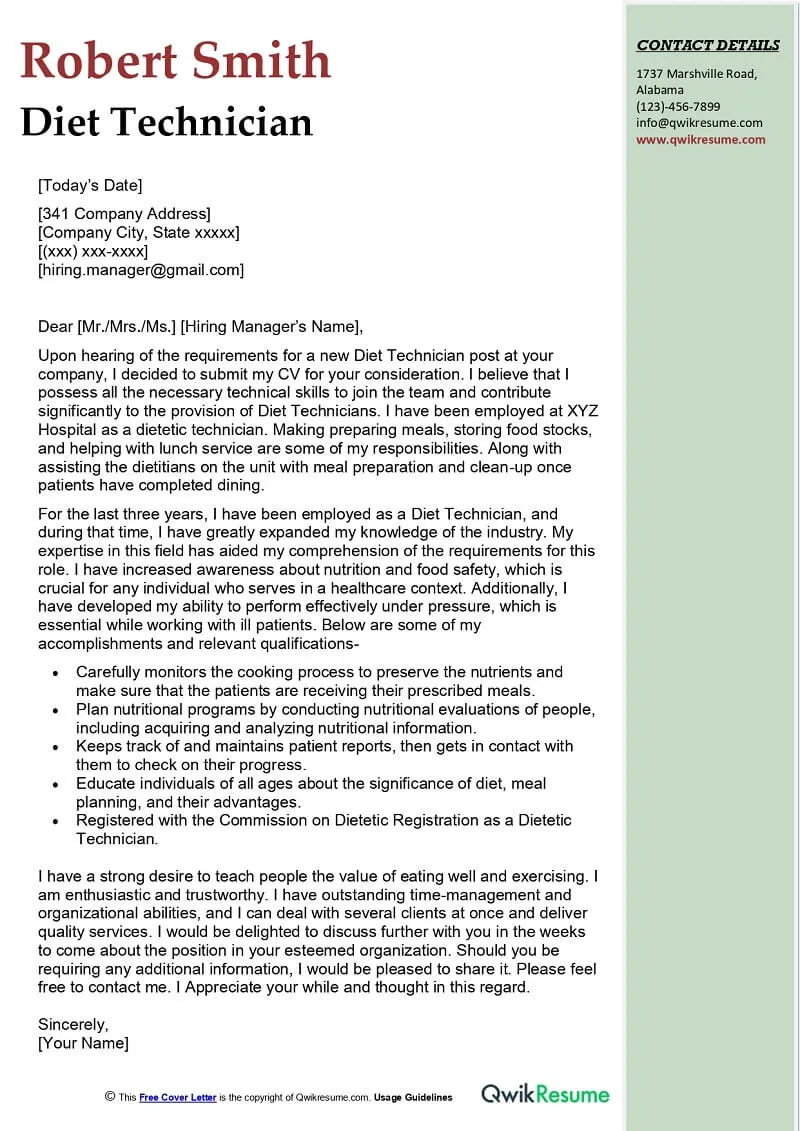
Customize your cover letter to match the job description. Identify the key skills and qualifications the employer seeks and directly address them in your letter. This shows that you’ve read the job description carefully and are a good fit for the role. Adapt your cover letter to highlight your relevant experiences and skills. Consider including details that reflect the specific needs of the organization, such as their patient demographics or the specialized services they offer. Tailor the language and tone of your cover letter to reflect the organization’s culture. Using keywords from the job description can also help your application get through applicant tracking systems. Demonstrating your familiarity with the organization and the job description sets you apart from other candidates, leading to an improved chance of getting an interview.
Formatting Your Patient Care Technician Cover Letter
The formatting of your cover letter is just as important as the content. Proper formatting makes your letter easy to read and shows your attention to detail. Use a professional font, such as Times New Roman or Arial, and maintain a consistent font size (11 or 12 points) throughout the letter. Ensure your cover letter is well-structured with clear paragraphs and plenty of white space. This enhances readability and makes it easier for the hiring manager to quickly grasp the key information. A well-formatted cover letter demonstrates professionalism and attention to detail. Maintain a professional look by using standard margins (1 inch on all sides) and aligning your text to the left. The correct formatting creates a polished impression.
Contact Information and Date
Start your cover letter with your contact information, including your name, address, phone number, and email address. Include the date of the letter. The date helps the employer to verify when the letter was written, which can be helpful for tracking purposes. This helps the hiring manager easily contact you if they want to schedule an interview. Ensure that all contact details are accurate and up-to-date. If you have a LinkedIn profile, consider including the link to your profile to provide more professional information. It’s a standard practice and provides all the necessary details at the beginning of the letter, making it easy for the reader to reach you. Placing the date allows the hiring manager to quickly grasp the current date of the application, which could be relevant to the review process.
Professional Greeting
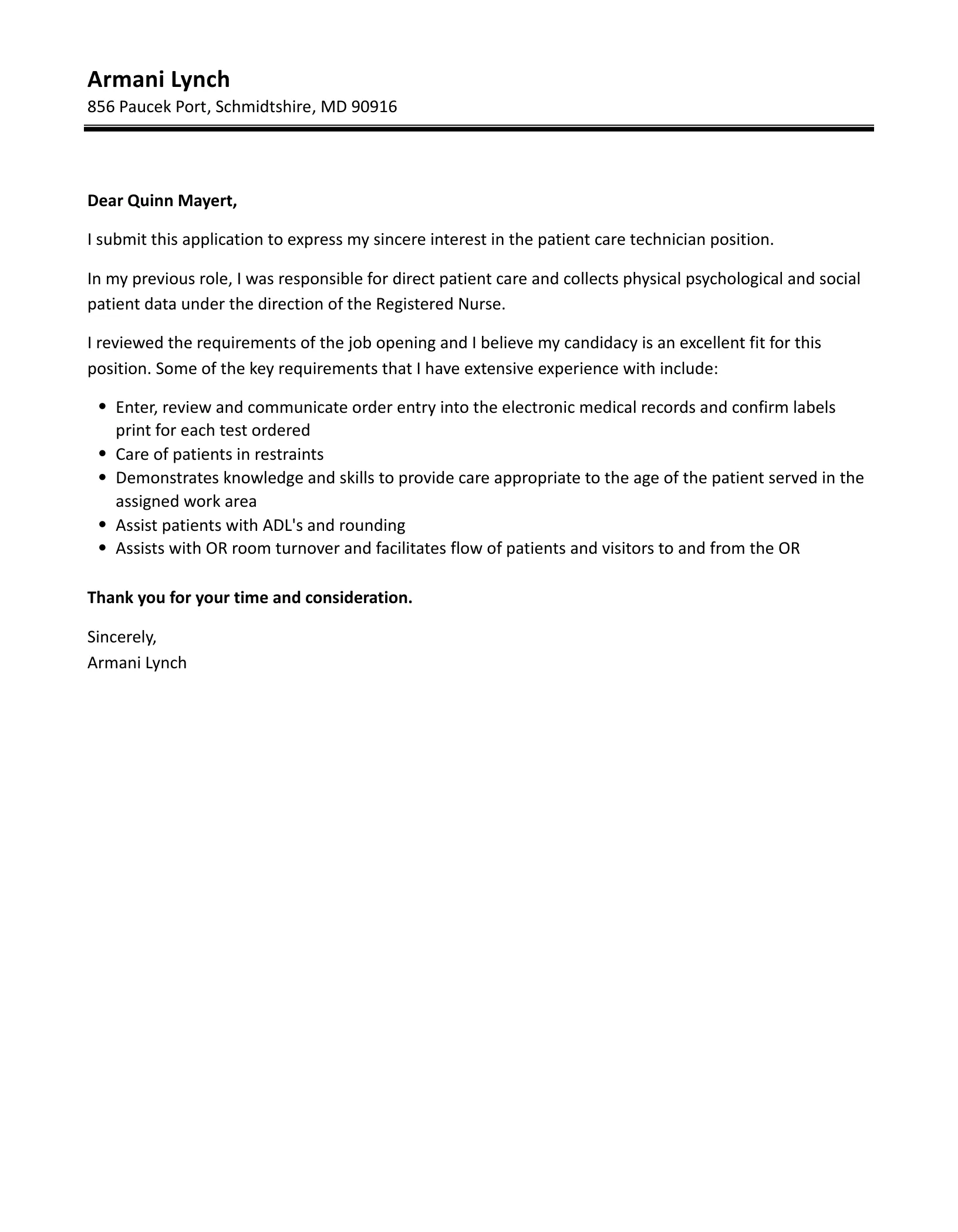
Begin your cover letter with a professional greeting. If you know the hiring manager’s name, use it; for example, “Dear Mr. Smith.” If you are unsure of the name, use a general greeting such as “Dear Hiring Manager.” Avoid generic greetings such as “To Whom It May Concern.” Tailor the greeting to the specific job application. Addressing the hiring manager directly, if possible, makes the letter more personal and demonstrates that you’ve taken the initiative to research the organization. Proper greetings set the tone for a professional and respectful interaction.
Body Paragraphs that Impress
The body paragraphs are the heart of your cover letter. Use them to highlight your relevant skills, experiences, and your enthusiasm for the role. Use strong action verbs and specific examples to demonstrate your capabilities. Each paragraph should focus on a specific aspect of your qualifications and tie back to the job description. Ensure that each paragraph contributes to building a compelling narrative that presents you as a strong candidate. Show how your skills align with the requirements of the position, and explain why you’re excited about the opportunity. Your cover letter should be well-organized and easy to follow, which enhances readability.
First Paragraph: Grabbing Attention
The first paragraph should grab the hiring manager’s attention. Start with a brief statement of your interest in the position, and mention where you learned about the opportunity. Briefly highlight your most relevant qualifications and explain why you are a good fit for the role. This paragraph should also set the tone for the rest of the letter and encourage the hiring manager to read further. Make a strong first impression by starting with a concise, engaging statement that immediately shows why you’re the perfect candidate for the job. Consider adding something unique about the organization or position to demonstrate your specific interest, showing your familiarity and genuine interest in the opportunity.
Second Paragraph: Showcasing Skills
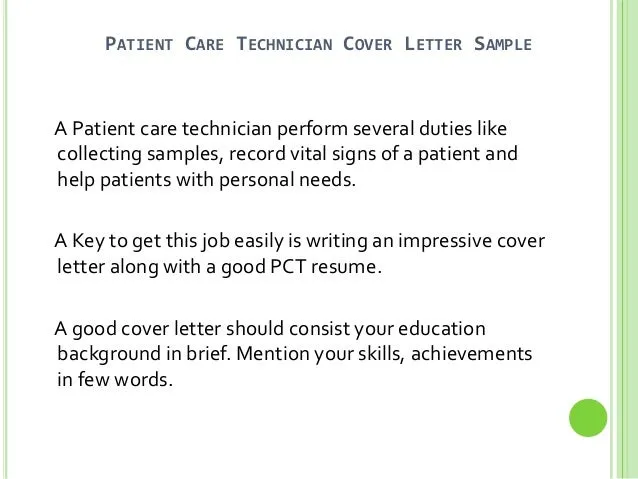
Use the second paragraph to showcase your skills and experience. Provide specific examples of how you’ve demonstrated your skills in the past. Tailor this paragraph to match the job description, emphasizing skills the employer is seeking. Quantify your achievements whenever possible, using numbers to demonstrate the impact of your work. This is where you connect your qualifications with the requirements of the job. Show examples, and illustrate how you’ve successfully applied your skills in a healthcare setting. Describe situations where you used your communication, empathy, or technical skills to provide quality patient care. Ensure that this paragraph effectively conveys your abilities and sets you apart from other applicants.
Third Paragraph: Demonstrating Enthusiasm
Use the third paragraph to show your enthusiasm for the role and the organization. Explain why you are excited about the opportunity and how you can contribute to their mission. Show your understanding of the organization’s values and patient care approach. Express your desire to grow and learn within the organization. Express your interest in their mission and the opportunity to provide excellent patient care. Convey your excitement by highlighting aspects of the organization that resonate with you. Show genuine interest in the role, by highlighting any long-term goals you might have for your career.
Closing Your Cover Letter
The closing of your cover letter is your final opportunity to leave a lasting impression. This section should be concise and professional, re-emphasizing your interest in the position and thanking the hiring manager for their time and consideration. Make sure you include a call to action that encourages the hiring manager to contact you. Also, ensure that you provide a professional thank you and a proper closing. Make sure that you convey your enthusiasm and professionalism until the very end.
Call to Action
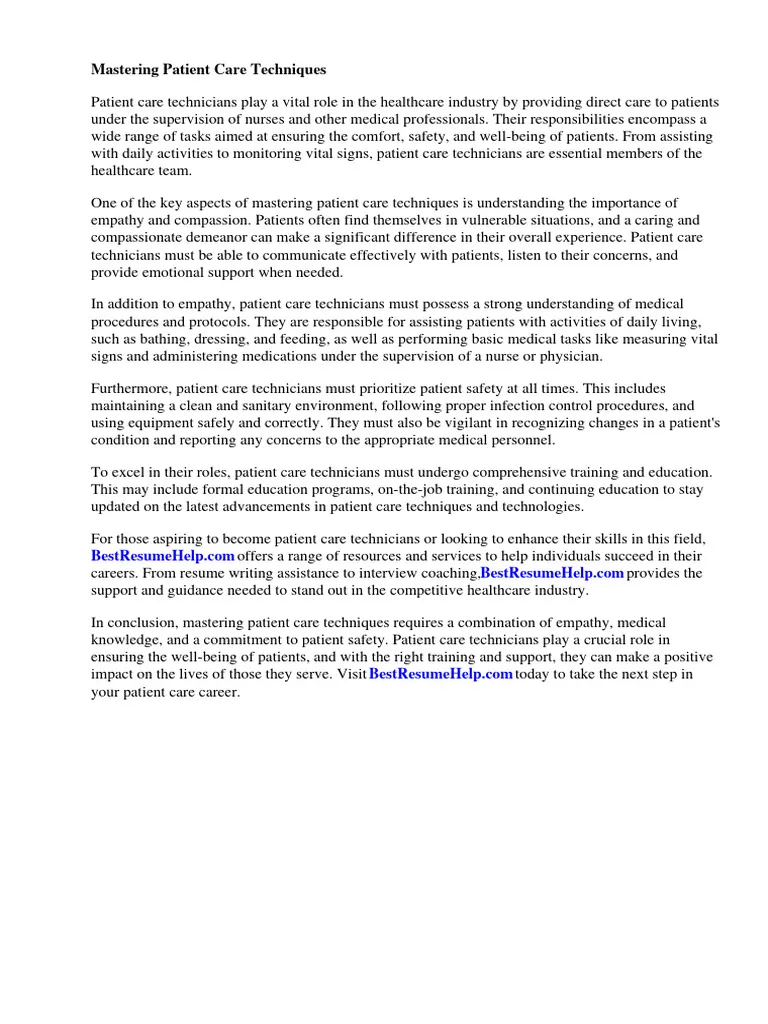
End your cover letter with a call to action. State your availability for an interview and express your willingness to discuss your qualifications further. Make sure you provide a clear invitation for the hiring manager to contact you. Include your phone number and email address. Request a specific next step, such as an interview, to encourage engagement. Make it clear how the hiring manager can reach you to continue the application process. A clear call to action shows your confidence and eagerness to move forward in the application process.
Thank You and Closing
Thank the hiring manager for their time and consideration. Use a professional closing, such as “Sincerely” or “Respectfully,” followed by your full name. By including a professional closing, you show your respect and appreciation for the hiring manager’s time. Provide your full name and contact information. Ensure that your contact information is accurate and up-to-date. Conclude your letter with a sense of professionalism and gratitude.
Proofreading and Editing Your Cover Letter
Before sending your cover letter, proofread and edit it carefully. Errors can undermine your credibility and make a negative impression. Check for typos, grammatical errors, and inconsistencies in formatting. Read your cover letter multiple times, or have someone else review it. Proofreading helps you identify and fix mistakes that could make your application look unprofessional. Proofreading minimizes errors, which are distracting and reflect poorly on your attention to detail. Review your cover letter at least two or three times before submitting it. Asking a friend, family member, or career counselor to proofread your cover letter can catch any missed errors.
